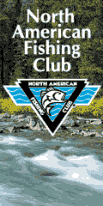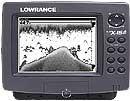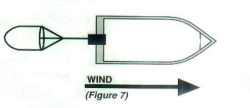
Free 90 day Risk free trial offer click
here





















|
Best Fishing Is Just Ahead
By Sam Anderson
A lot of people don’t realize that fish move on a seasonal and daily
basis, and when they move they use underwater structure, essentially the
bottom of the lake that is just a little different. Things like bars,underwater
humps and manmade structure like submerged roadbeds, leveesor riprap along
dams or causeways.
When a fish leaves its sanctuary, to eat or search for food, it has
to have something visual to follow. A fish is a stupid creature.
It cannot rationalize like a human being, and when it moves about it must
have something it can follow. Fish don’t swim about a lake haphazardly.
Not only can they see structure, but we can also locate the same structure
with our observations of land, depthfinders and the feel of the lures on
the bottom.
The most important thing to remember is that the larger a fish becomes
the tighter it schools and the more time it spends in deep water.
A fish lives there because it is forced there by environment over a period
of time. When a fish becomes an adult, its body takes longer to make
adjustments to the changing conditions of the water and weather.
It’s easier for it to make these adjustments in deep water. The deeper
you go, the more stable conditions will become. A fish can stay there
for weeks. It doesn’t have to move into the shallows all summer.
Is there enough food and oxygen down deep to support fish populations?
Absolutely there’s food. There are shad, baitfish, and bluegills
at 35 feet and deeper. A fish’s menu may change and it may be less
selective, but it doesn’t have to move shallow to feed. However,
you should keep this in mind: When a fish is down deep it’s probably dormant
and its body requires less food. It is just sitting there and not
expending any energy, so it really doesn’t need a lot of food. This
also makes for difficult fishing, and you have to get your lures closer
to them. A strike zone can be very small in deep water, because of
visibility and the lethargic nature of the fish.
We all know that a fish requires certain amounts of oxygen to survive.
You must remember that a fish is a very adjustable creature, and when there
is a very small amount of oxygen in an area it will adjust unless the situation
gets to a point where there is just not enough to survive. But no
one has proven that a fish has a preferred oxygen zone. Structure
in relation to deep water is our guide to finding fish.
On the flats, the weather has less of an impact than it does in shallow
water. Fish favor stability. Relatively constant water temperature,
water quality, weather, and abundance of prey let fish live predictably.
Good fishing often accompanies stable conditions, but sometimes when weather
is poor fishing is the best on the flats. Flats are the major food-producing
regions of most lakes. Walleyes forage over flats. Therefore,
the flats are the home of walleyes.
It's easy to identify productive flats. Some prime flats drop
off steeply into the deepest areas of the lake. Walleyes that use
flats typically move shallower at night to feed on a variety of prey species.
Baitfish such as cisco and shad move shallower at dusk.
The depth of a good flat can very from only a few feet to over 20, depending
upon the lake and the season. Flats with a fairly soft or sandy bottom
carpeted with low weeds, with patches of coontail or cabbage rising above
the carpet, attract walleyes. Submerged weeds develop as the water warms
in the summer. Weedy flats hold baitfish that attract walleyes at
night.
In fall, weeds decline and small fish are flushed from cover.
Walleyes feed aggressively throughout this period. Walleyes can feed
in dim light. They have a feeding advantage over most prey species
after dark. When fishing these humps I rely on my depthfinder to tell me
if anyone is home on these humps. I usually like to look for a good
shelf that comes out from an island that has boulders on it. This
is the structure that many walleye key in on to rest and ambush their prey
as they slide back and forth from the hump to deep water. These are
transition areas where the fish come to feed. These humps provide
a structure for baitfish that have moved out into deep water as schools,
and are lookingfor a place to rest. Naturally, what attracts the
baitfish also attracts the walleye.

Lowrance’s
new X-15 |
The other thing that my Lowrance
X-15 depthfinder unit allows me to see is how active these fish are.
Many times you can go over the hump and you will see that the walleyes
are moving up to the top portion of the hump, this signifies that they
are in a positive mood and within minutes you should be landing a nice
plump walleye in your boat. |
Big fish become vulnerable for longer periods in early fall because
they move into areas where baitfish are staging, some remaining in the
general area through winter. To catch walleyes during fall transition
and early fall consider the tendency for walleyes to move up. During daylight,
if you can't fish during perfect conditions, it is usually better to concentrate
on deep fish, rather than shallow fish. You should look for fish holding
areas where wind crashes against a barrier or where the wind churns up
the water rather than fishing where it is calm. Concentrate on dark
water lakes that have a high percentage of fish caught during the day.
Sometimes in dark mucky waters, high bright sun filled days trigger a feeding
frenzy because the sunlight gets all the tiny critters moving and in the
cycle of fishing the end of the food chain will be the bigger fish.
Constant bottom contact is essential even though it increases the potential
for snags. Use a small jig head with a wide hook gap to deliver the
bait in wavy conditions. Leeches are an outstanding rock bait because
they can take the pounding. Holding on top of a hump on a windy day is
a way to catch trophy
walleyes. One way that I have solved the problem with boat control
is by
using a sea anchor. A sea anchor is a cone-shaped under water
wind
sock, similar to those at airports that detect changes in wind
direction.
 Drift Control Sea Anchor
Drift Control Sea Anchor
|
Use with you bow mounted electric trolling motor by tying to the stern
of the boat. This adds more precise boat control and allows you to
follow the contour of the shoreline or hold on structure |
 osea
anchors aid boat control in two ways.first of all, they slow your drift
in strong winds. Secondly, you can use them to fine-tune subtle boat
maneuvers in rough seas or heavy current. The tackle is simple and
the methods are easy to learn. osea
anchors aid boat control in two ways.first of all, they slow your drift
in strong winds. Secondly, you can use them to fine-tune subtle boat
maneuvers in rough seas or heavy current. The tackle is simple and
the methods are easy to learn.
First, use jigs tipped with a crawler, leech or minnow. The size
of the jig should be just enough so you have contact with the bottom. Whenever
you must fish in adverse conditions, being either bright sunny days or
changing weather conditions, there should be a two step approach.
One way is to slow down your presentation. Go slow, use the  trolling motor and make your presentation very slow. Maybe even put
on a single hook with split shot rather than a walking sinker and vibrating
blades. Or the second approach is to go fast. Use fast trolling
speeds with artificial lures and speed troll breaklines to get the fish
active enough to bite. Keep these tips in mind when you venture out and
remember the best fishing is yet to come. Don’t give up, try different
approaches when times get tough and you will see what I mean about the
best fishing. I would also like to hear from you and you can contact
me at
trolling motor and make your presentation very slow. Maybe even put
on a single hook with split shot rather than a walking sinker and vibrating
blades. Or the second approach is to go fast. Use fast trolling
speeds with artificial lures and speed troll breaklines to get the fish
active enough to bite. Keep these tips in mind when you venture out and
remember the best fishing is yet to come. Don’t give up, try different
approaches when times get tough and you will see what I mean about the
best fishing. I would also like to hear from you and you can contact
me at
www.samanderson.com.
Hope hear from you soon.

Walleyes Inc. website is maintained
by Randy
Tyler Fishing the In-Fisherman Professional Walleye Circuit, Masters
Walleye Circuit and the Team Walleye Circuit. All rights reserved.Copyright
1999/2001
Please visit these site sponsors
Daiichi/Tru-Turn Hooks,
Lindy
Little Joe,
R-A.M Mounting Systems,
Ranger
boats, Mercury Marine, Bedford
Sales , Hamby's Beaching Bumpers,
Goldeneye
Marine products, Panther
Marine Products, Webfoots body
sock, Bait Rigs Tackle
|



 osea
anchors aid boat control in two ways.first of all, they slow your drift
in strong winds. Secondly, you can use them to fine-tune subtle boat
maneuvers in rough seas or heavy current. The tackle is simple and
the methods are easy to learn.
osea
anchors aid boat control in two ways.first of all, they slow your drift
in strong winds. Secondly, you can use them to fine-tune subtle boat
maneuvers in rough seas or heavy current. The tackle is simple and
the methods are easy to learn.

